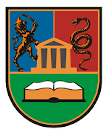Please use this identifier to cite or link to this item:
https://scidar.kg.ac.rs/handle/123456789/21997Full metadata record
| DC Field | Value | Language |
|---|---|---|
| dc.contributor.author | Čebašek, Aleksandra V. | - |
| dc.date.accessioned | 2025-01-27T12:59:09Z | - |
| dc.date.available | 2025-01-27T12:59:09Z | - |
| dc.date.issued | 2024 | - |
| dc.identifier.isbn | 978-86-80596-72-3 | en_US |
| dc.identifier.uri | https://scidar.kg.ac.rs/handle/123456789/21997 | - |
| dc.description | Zbornik je rezultat istraživanja u okviru Studija Holokausta koje se pod pokroviteljstvom Claims Conference (Conference on Jewish Material Claims Against Germany) izvode na Univerzitetu u Kragujevcu | en_US |
| dc.description.abstract | Primarily, the intention of the work is to provide an insight into the content of the study My Good Father: Life with His Past by Beate Nieman. It is interesting that the author of the study is the daughter of the head of the Gestapo, Bruno Sattler. The daughter re-examines and rewrites her father’s biography, coming to the terrible truths related to the war actions in which he participated. Then, the goal is to focus on the thematization of the Second World War in Yugoslavia, which the author is talking about, with special attention to the events in Belgrade in the period from 1942 to 1944, since in that period the author’s father was in charge for operations where were killed women, children, and men in death trucks - soul-sucking trucks. The goal is to point out the crimes committed at the Staro sajmište, highlight them and adequately connect them with historical knowledge so far. The author’s research on her father’s crimes affects her perception of him as her father, but, not running away from the truth, but facing it, Beata Nieman thoroughly explains the events in Belgrade based on numerous documents, references, records, photographs. Decades after these crimes, the author visits Belgrade in the desire to face history, the truth, and one can say with her father, since she remains in the unfathomable position of a human being to knowingly agree to commit genocide against an innocent people. Being sentimental about what she witnesses, the visit to Belgrade and the experience of meeting the dead represent a impressive section of this study. | en_US |
| dc.language.iso | sr | en_US |
| dc.publisher | University of Kragujevac, The Faculty of Philology and Arts | en_US |
| dc.relation | MSTDI - 451-03-66/2024-03/200198 | en_US |
| dc.relation.ispartof | Holokaust, sećanje, kultura (III) | en_US |
| dc.subject | History | en_US |
| dc.subject | Holocaust | en_US |
| dc.subject | Belgrade | en_US |
| dc.subject | Old Fairground | en_US |
| dc.subject | Bruno Sattler | en_US |
| dc.title | Beograd i otac-zločinac u studiji Moj dobri otac: život sa njegovom prošlošću Beate Niman | en_US |
| dc.title.alternative | Београд и отац-злочинац у студији Мој добри отац: живот са његовом прошлошћу Беате Ниман | en_US |
| dc.title.alternative | BELGRADE AND THE CRIMINAL FATHER IN MY GOOD FATHER: LIFE WITH HIS PAST BY BEATE NIMAN | en_US |
| dc.type | article | en_US |
| dc.description.version | Published | en_US |
| dc.type.version | PublishedVersion | en_US |
| Appears in Collections: | The Faculty of Philology and Arts, Kragujevac (FILUM) | |
Files in This Item:
| File | Description | Size | Format | |
|---|---|---|---|---|
| HolokaustSecanjeKultura, Čebašek.pdf | 1.97 MB | Adobe PDF |  View/Open |
Items in SCIDAR are protected by copyright, with all rights reserved, unless otherwise indicated.

